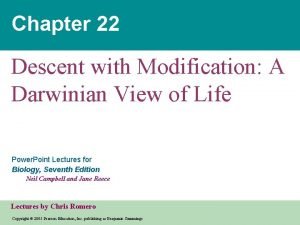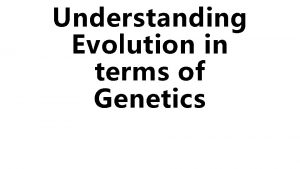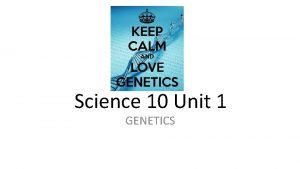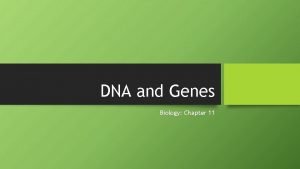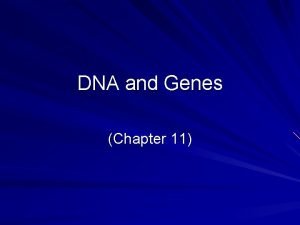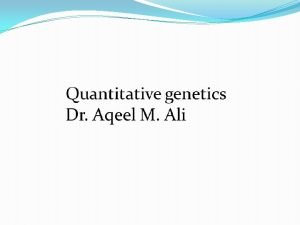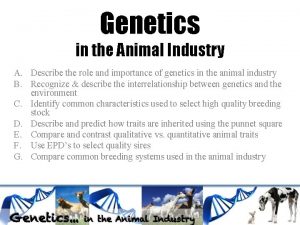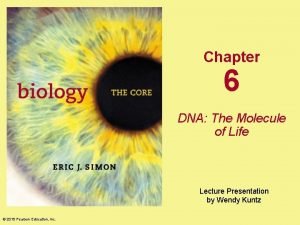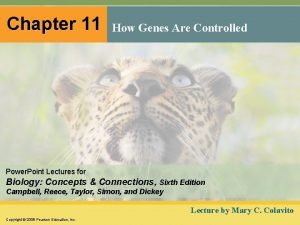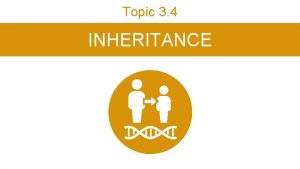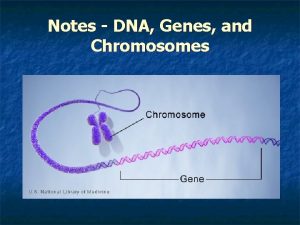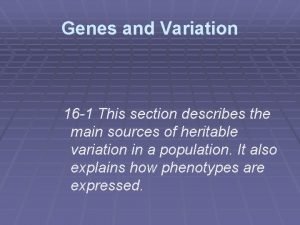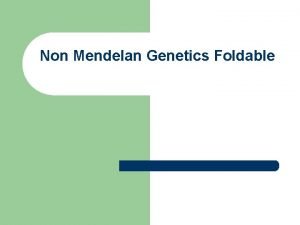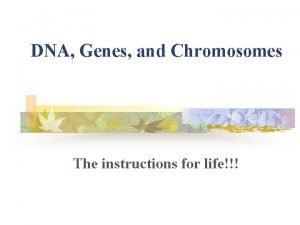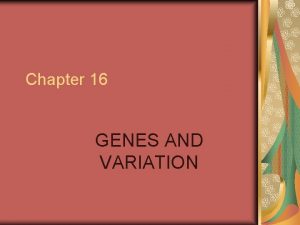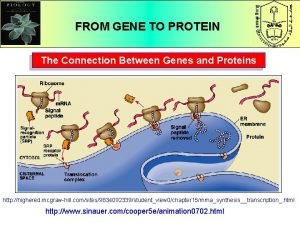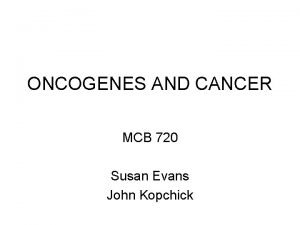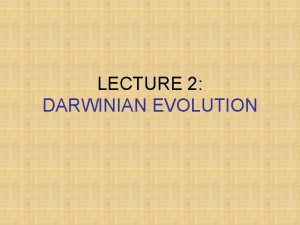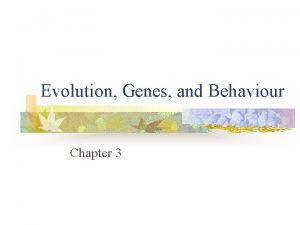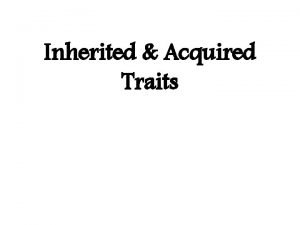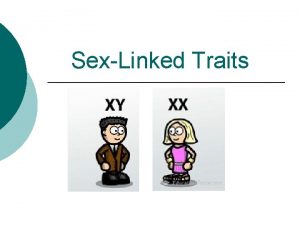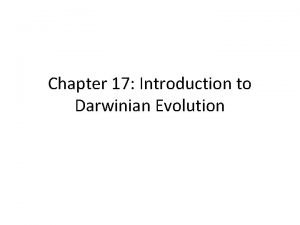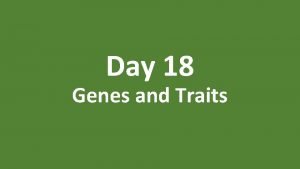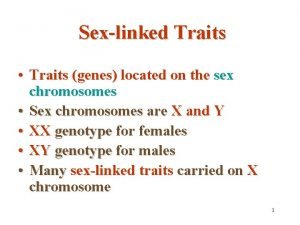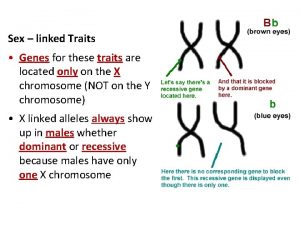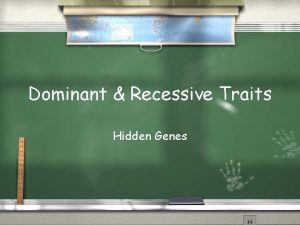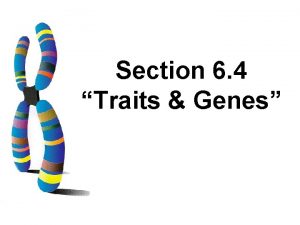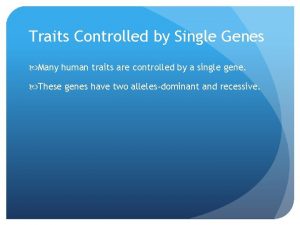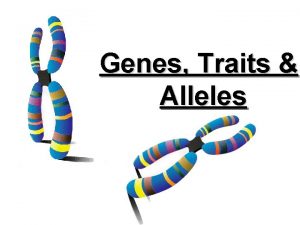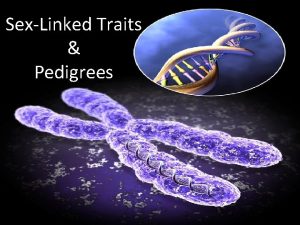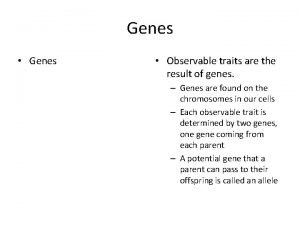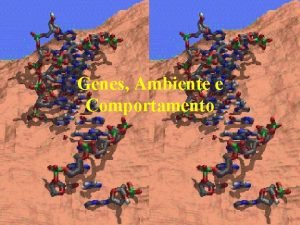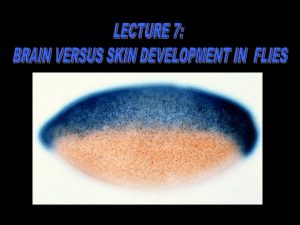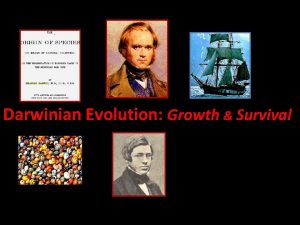Chapter 20 Evolution of Genes and Traits Darwinian





























- Slides: 29

Chapter 20 Evolution of Genes and Traits Darwinian evolution, mutations and molecular evolution, a case study in natural selection, morphological evolution; the origin of new genes and protein functions

Major principles of Darwinian evolution • Principle of variation—among individuals in a population, variation exists • Principle of heredity—offspring resemble parents more than unrelated individuals • Principle of selection—some forms more successful at survival and reproduction in a given environment (natural selection) • heritable variation heritable differences between populations over time

Phyletic evolution – continuous change over time in a single line of descent Diversification – the origin of new species over time

Darwin’s Finches and Adaptive Radiation A phylogenetic tree is a visual representation in tree form of how we think evolution has occurred, often based on fossils. Famous example: Galapagos finches, with numerous feeding adaptations

Neo-Darwinian evolution—Darwin’s principles w/genetics, population biology

Different models of selection • Directional selection- pushes population toward homozygosity and phenotypes toward one extreme • Balancing selection- favors heterozygotes but maintains all phenotypes • Disruptive selection- favors both homozygotes, eliminates heterozygotes and increases extremes of phenotypes

Mutations and Molecular Evolution • 3 different effects on fitness by mutations: – deleterious – increase efficiency or performance – no effect (“neutral”) • can be a little more specific: – effectively neutral mutations selection intensity so low that mutation is retained – effectively selected mutations selection high enough that mutation is weeded out

Mutation rate of synonymous sites higher than nonsynonymous Synonymous changes refer to a mutation which substitutes the same amino acid Deleterious mutations removed by purifying selection-shown by lower rate of nonsynonymous mutations

MOLECULAR CLOCKS: mutations/amino acid differences can be used to estimate evolutionary divergence times

Natural Selection in Action: An exemplary case • Genotypes could be measured • The genetic and molecular basis of variation was identified • The physiological role of the gene/protein was well understood • The environmental (natural) selection process was understood • We are talking about the connection between sickle cell anemia and malaria

Malaria Life Cycle

Red blood cells in someone with sickle-cell trait

Malarial parasites live within red blood cells

Electrophoresis of hemoglobin variants

The hemoglobin molecule

The first seven N-terminal amino acids in normal and sickle cell hemoglobin polypeptides GAG GUG GLU = Glutamic acid is acidic VAL = Valine is neutral non-polar

Gene frequency for Hb. S allele high in malaria (mosquitoes-rich) zones Hb. AS heterozygous are more resistant to malaria

Survival analysis of sickle-cell genotypes

Morphological evolution-melanism in rock pocket mouse (adaptive changes)

Morphological evolution—melanism in rock pocket mouse • Pinacate region of SE Arizona has blackish lava rock areas interspersed with pale brown rock areas • rock pocket mouse (Chaetodipus intermedius) has 2 melanic forms growing in 2 different substrates – dark form inhabits blackish areas – pale ancestral form lives in sand-colored areas • Nachman et al. found 4 mutations in melanocortin 1 receptor (MC 1 R) gene of dark mice, causing protein to be constitutively active and lay down pigment constantly

Morphological evolution—melanism in MC 1 R protein of organisms

Peppered Moths in Great Britain

Morphological evolution-evolution of albinism in blind cave fishes (gene inactivation)

Morphological evolution—albinism in blind cave fishes • albinism common in cave organisms (incl. fishes, crustaceans), often accompanied by eye loss • genetic studies of Mexican blind cave fish (Astyonax mexicanus) in 2 different populations, Pachón and Molino, revealed different mutations in Oca 2 gene—gene inactivation • Pachón fishes are homozygous for deletion of intron and most of exon in Oca 2 gene

Morphological evolution-wing spots on fruit flies (regulatory sequence evolution) Drosophila melanogaster Drosophila biarmipes

Origin of New Genes • New genes and proteins necessary for wholly new functions and processes • Sources of new genes/DNA: – Polyploidy-duplicate genomes can diverge – Gene duplications-duplicated genes can diverge – Transposition (transposable elements) – Retrotransposition (retrotransposons) – Imported DNA from organelles or horizontal gene transfer

The alternative fates of duplicated genes


Final Thoughts • The one process now going on that will take millions of years to correct is the loss of genetic and species diversity by the destruction of natural habitats. This is the folly our descendants are least likely to forgive us. -E. O. Wilson • It's an important point to realize that the genetic programming of our lives is not fully deterministic. It is statistical - it is in any animal merely statistical - not deterministic. --Richard Dawkins • If you liked genetics (PBIO 3300/5300), consider taking biotechnology and genetic engineering (PBIO 4500/5500) in the fall. –Allan Showalter
 Linked genes and unlinked genes
Linked genes and unlinked genes Polygenic inheritance
Polygenic inheritance What are homeotic genes
What are homeotic genes Descent with modification: a darwinian view of life
Descent with modification: a darwinian view of life Darwin
Darwin Stabilizing selection human birth weight
Stabilizing selection human birth weight Evolution of populations section 16-1 genes and variation
Evolution of populations section 16-1 genes and variation Convergent evolution
Convergent evolution Genes to traits
Genes to traits Chapter 11 dna and genes
Chapter 11 dna and genes Dna and genes chapter 11
Dna and genes chapter 11 Chapter 11 dna and genes
Chapter 11 dna and genes Quantitative traits
Quantitative traits Qualitative traits vs quantitative traits
Qualitative traits vs quantitative traits Qualitative traits vs quantitative traits
Qualitative traits vs quantitative traits The age of genes chapter 6
The age of genes chapter 6 Chapter 11: how genes are controlled
Chapter 11: how genes are controlled Chapter 2 risk factors behavior genes environment
Chapter 2 risk factors behavior genes environment Dominant versus recessive
Dominant versus recessive The relationship between genes dna and chromosomes
The relationship between genes dna and chromosomes Dominant and recessive genes
Dominant and recessive genes Genetics is the study of heredity
Genetics is the study of heredity Section 16-1 genes and variation
Section 16-1 genes and variation Chapter 16 evolution of populations
Chapter 16 evolution of populations Dominant and recessive genes
Dominant and recessive genes Chromosomes genes and basic genetics foldable answer key
Chromosomes genes and basic genetics foldable answer key Dna, genes and chromosomes relationship
Dna, genes and chromosomes relationship Section 16-1 genes and variation
Section 16-1 genes and variation What is the connection between genes and proteins
What is the connection between genes and proteins Difference between proto oncogene and oncogene
Difference between proto oncogene and oncogene



